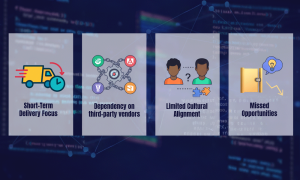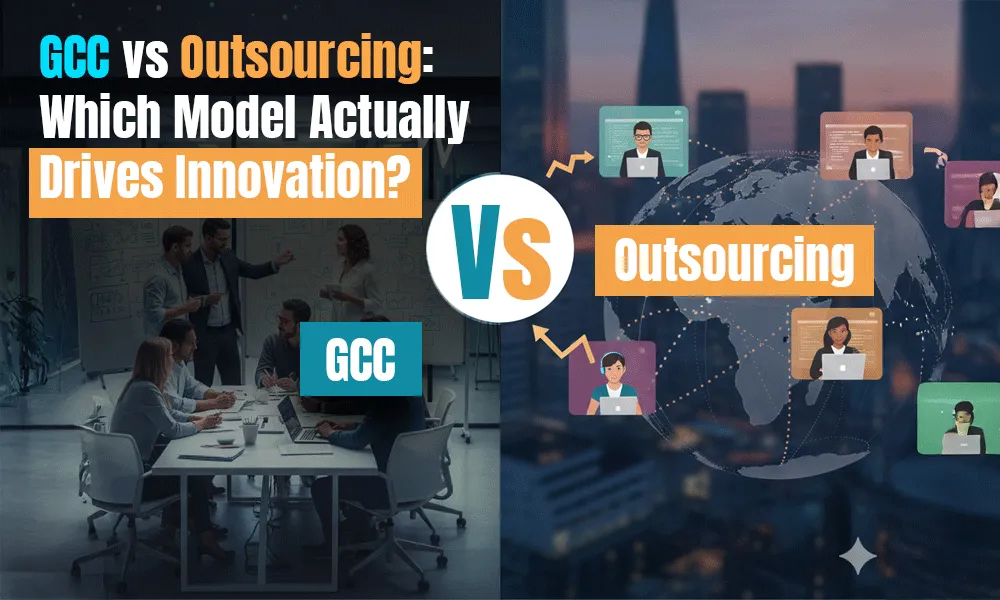Outsourcing, with its numerous flaws, has been on the back burner for decades now, yet businesses still rely on it despite its shortcomings and other alternatives. Why? Because of their unfamiliarity with alternative hiring models that far outweigh outsourcing’s benefits, this concept is now outdated.
The hiring model we talk about here in this blog is global capability center services, which have virtually replaced outsourcing. The rise of the global capability center operating model since the 1990s-early 2000s, located in countries like India, the Philippines, and Eastern Europe, started changing the ‘back office’ narrative associated with both outsourcing and GCCs.
GCCs (especially global capability centers in India) not only save cost while providing quality, but they also enhance innovation like never before, thereby bridging the gap between research and development and agentic outsourcing. All while introducing the element of control for business owners to the equation, and that is what we intend to explore further in this blog.
Outsourcing vs. Global Capability Center – What’s the Debate?
The GCCs, or so-called erstwhile ‘captive centers,’ began to move beyond basic functions like IT services. From the early ‘90s it supplied the market with product engineering, finance, human resources, cybersecurity, research and development, digital transformation, customer experience, and supply chain services.
It now also embraces more innovative and strategic functional arms like artificial intelligence and machine learning, data science, and analytics.
In that shift away from the functions global capability centers started serving lies its primary distinction from traditional outsourcing in a global economic landscape where cost-cutting is not the primary concern of companies anymore.
How Outsourcing Holds Innovation Back?

Short-term delivery focus: Traditional outsourcing companies are more bothered with getting all their employees placed on various projects of the clients they handle, not long-term strategy focused exclusively on the growth of one particular business.
Dependency on third-party vendors: Heavy reliance on external systems in the outsourcing ecosystem limits internal knowledge-building and leaves little (if any) room for experimentation, creativity, or innovation-led thinking in execution.
Limited cultural alignment: These vendors, because they operate outside the company’s ecosystem, do not really share their vision, thus heightening the risks around intellectual property protection.
Missed opportunities: Perhaps the biggest con of outsourcing is innovation and creativity – which these third-party vendor teams often fall prey to in terms of lost chances to build products based on market insights.
How GCCs Generate Value at CAGR 10–11%?
Centralized teams: GCCs operate as extensions of the parent company, aligning closely with headquarters on strategic goals, a perfect organizational behavior model that fosters collaboration across functions and geographies. This further ensures that whatever they are creating is not slowed down but driven as part of the larger business agenda of seamless product development and speedy go-to-market.
Proximity to tech talent density: India’s vast pool of highly skilled and specialized professionals offers companies ready access to world-class expertise in in-demand domains like artificial intelligence, machine learning, cloud computing, cybersecurity, and data science. Through the Indian global capability center model, you can work directly with them to speed up development, experimentation, and deployment of innovative digital solutions that win you a competitive advantage.
End-to-end ownership: Unlike traditional outsourcing, GCCs are entrusted with full product or end-to-end process ownership – from design to delivery – helping develop a stronger sense of accountability as well as autonomy among teams, resulting in faster innovation cycles, higher quality outputs, and seamless alignment with customer and business needs.
Drivers of the AI revolution: Global Capability Center India hubs are leading the charge in artificial intelligence innovation and advanced supply chain analytics by developing next-gen solutions that optimize operations, predict market shifts, and enhance decision-making – thus, transforming India-based GCCs into global centers of excellence (COE) across industries like retail, healthcare, and logistics.
Why India is the GCC Capital?

India has firmly established itself as the global capital for Global Capability Centers (GCCs), and for good reason. With the largest pool of digitally skilled talent – including engineers, data scientists, and AI specialists – India offers companies a unique advantage in building innovation-ready operations at scale. The country produces over a million STEM graduates annually, feeding a dynamic workforce that’s both tech-savvy and globally competitive.
Global giants in technology (Google, Microsoft, Cisco), BFSI (JPMorgan, Goldman Sachs), pharmaceuticals (Pfizer, Novartis), and retail (Walmart, Target) have set up thriving centers in India that go beyond back-office support to lead in R&D, product engineering, and digital transformation.
In fact, PwC India’s latest research survey article, published in June 2025, of 120 senior executives each from GCCs and their respective HQs reveals that during FY20–24, GCCs generated value at a weighted average compounded annual growth rate (CAGR) of 10–11% for their respective HQs.
Recent GCC growth trends highlight India’s acceleration as the preferred destination. Reports and news consistently show rising investments, expansion into Tier 2 cities, and an increasing focus on innovation-driven capabilities.
Supporting this ecosystem are numerous India Global Capability Center consulting firms that specialize in helping mid-sized and enterprise businesses establish and scale high-performance centers. These firms provide everything from talent strategy to tech enablement, ensuring that new GCCs are built with a future-ready, innovation-first mindset – solidifying India’s leadership in the global GCC landscape.
So, Who Wins the Race?
To summarize, traditional outsourcing may offer quick cost savings through access to cheap labour, but it often comes at the expense of long-term innovation, agility, and strategic ownership.
Outsourcing tends to prioritize short-term project delivery, depends heavily on external vendors, lacks cultural alignment, and misses critical opportunities for customer-driven product innovation and R&D.
In contrast, Global Capability Centers (GCCs) – especially those based in India – have emerged as the smarter, strategic, long-term, innovation-driven alternative, handling artificial intelligence, data science, product engineering, cybersecurity, and digital transformation.
In today’s landscape of interconnected economies marked by global supply chains, the Indian global capability center operating model proves far more effective than outsourcing in driving sustainable innovation and long-term value.




